Content
Carl Barks & Donald Duck

When the drake turned human
He was one of the great artists of the 20th century: Carl Barks. You don't know this name? Well, so did many of his biggest fans for a long time. In his active days, he was known only as the anonymous "good artist" in the Disney team of comic authors. Barks was already retired when persistent admirers finally found out who had conceived and drawn those brilliant stories about Donald Duck. But then Carl Barks slowly became known worldwide - as probably the most important comic artist of our time.
25th anniversary of Carl Barks' death
The wonderful ‘Duck Man’, one of the most important comic artists of the 20th century, died a quarter of a century ago, on 25 August 2000. Sniff! But of course he lives on forever in Donald and in the hearts of his fans... Cheers!
Carl Barks was born on 27 March 1901 on a farm near Merrill in Oregon. Similar to his alter ego Donald Duck, he tried his hand at numerous jobs over the decades, for example as an errand boy, chicken farmer, railwayman, farmer, lumberjack or printer's assistant. Drawing remained a hobby until he was able to sell some cartoons to the "Calgary Eye-Opener" in 1928. From then on, he regularly delivered frivolously humorous drawings to this and other papers.
Meeting Donald
When the Disney studios were looking for so-called "interframe artists" for their first full-length animated film "Snow White" (see e.g. EM003332848, EM009779604) in 1935, Barks applied successfully. There it came to the fateful encounter with Donald Duck, who had made his first appearance the year before. Barks sketched a scene with the drake that pleased Walt Disney. He promoted him to the story development department.
In 1942, however, Barks resigned from Disney and shortly afterwards applied to Western Publishing, which produced comic books with Disney characters under licence. In the following two decades, he created an oeuvre as a freelance comic artist that includes over 500 stories with more than 6000 pages.
A work for eternity
Barks' comics came - which was and is by no means usual - completely from his own hand, from the idea to the text to the realm drawing. Especially his long stories with the Ducks, which went beyond the typical 10-page comic strips of the time, are regarded by fans today as a kind of world cultural heritage.
He also invented some of the most important characters in Duckburg (also created by him): Gladstone Gander, the Beagle Boys, Magica De Spell, The Junior Woodchucks organization and above all Uncle Scrooge, the richest and stingiest duck in the world, who seems to combine all the dark sides and advantages of capitalism.
Barks retired on 30 June 1966, still largely unknown. But his fans had by now found out who the legendary "good artist" behind the very best duck stories was. Barks was now slowly gaining world fame. From 1971 onwards, he painted oil paintings with scenes from his Duck stories for a few years with Disney's special permission, which are highly sought after by collectors. He had to live to the age of 82 before his stories could be published under his name for the first time. Many consider "his" Donald Duck - his complete works - to be one of the most important works of art of the 20th century. Carl Barks died on 25 August 2000 in Oregon.
In his 90s and and still going strong
Probably the most famous comic figure on the planet today (next to Mickey Mouse from the same company), Donald Duck is over 90 now and still the single father (officially: uncle) of triplets.
On June 9, 1934 Donald Fountleroy Duck (so his complete name) had his first appearance as a supporting actor in the cartoon "The Wise Little Hen". In the movie, the drake lives on a boat, and that is why he wears a sailor´s jacket – as he still does today (and still no pants!).
Because Micky Mouse, the older, bigger star, had to become more and more serious, brave and colorless with increasing fame, Disney needed an anti-hero, a counterweight to the tame mouse. Donald was – aside of all his original cuteness - a duck with deeply human weaknesses: he is unpredictable, clumsy, quick-tempered and lazy, yet struggling and unbroken.
The duck that was /hu-)man
And it was precisely this humanity that helped the figure achieve rapid, enormous popularity that continues to this day. Walt Disney, a clever businessman, skilfully used intellectual property rights to market his creations exclusively and effectively. Not only Donald (trade marks (002828341, 005240271, 003335668)), but practically all popular cartoon characters of the Disney stories are protected by IP rights. To this day, global player Disney, who ownes - among many other things - the rights to Star Wars, operates very successfully with the protection of its intellectual property and makes a lot of money with merchandising (though not only). In contrast, Donald is chronically broke.
Cheer! Applaude! Wonder!
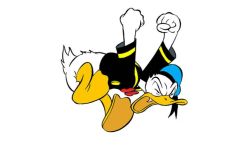
Donald, drawn by Carl Barks
The brilliant translator Dr. Erika Fuchs contributed to the cult status of the Donald comics in Germany. She raised the dialogues, which were mostly much simpler in the American original, to an almost literary level, enriched with classic quotations, cult puns, virtuoso use of alliterations as a stylistic device.
Above all, she enriched the German language with an inventive grammatical clause, later called "Erikativ" in her honour: verbs are shortened to the root of the word (inflectives) and get a onomatopoeic, suggestive and illustrative effect: Gulp! Moan! Gargle!
Ducking patents
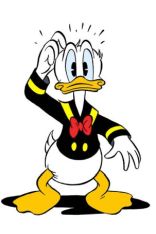
Another Barks original
Barks' stories must have inspired many budding inventors, as the most amazing technical developments often appear in them: Diving equipment with self-renewing breathing air, for example, intelligence rays, flying brooms, leprechaun compensators, indestructible plastic. Mostly Gyro Gearloose (in German: Daniel Düsentrieb) is responsible for this, an anthropomorphic rooster and inventor who stimulates his thinking with hammer blows to the brain box.
The world-famous drake also appears frequently in patent literature: If you search his name in the DPMA database DEPATISnet, you will find a large number of very different references to the figure in patent and utility model documents (e.g. ![]() DE1996437U,
DE1996437U, ![]() EP2339497A2).
EP2339497A2).
How Donald overturned a patent
In 1964, a Danish inventor applied for a patent in his home country for a method of lifting sunken ships, in which foam balls were pumped into the wrecks to give them buoyancy. The patent was also confirmed by the DPMA ( ![]() DE1247893B) and in Great Britain (
DE1247893B) and in Great Britain ( ![]() GB1070600A).
GB1070600A).
But the patent office of the Netherlands refused to grant it: In a story by Carl Barks published as early as 1949, Donald Duck had used a very similar procedure to lift a sunken yacht with the help of table tennis balls. In view of the large circulation of the comics, the Dutch colleagues no longer saw the novelty of the invention.
Donald Duck should therefore be declared a must-read for patent examiners... Giggle!
Text: Dr. Jan Björn Potthast; Pictures: Disney (Drawing by Carl Barks), Alan Light CC by 2.0 via Wikimedia Commons, DPMAregister
Last updated: 10 December 2025

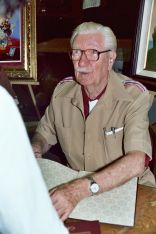
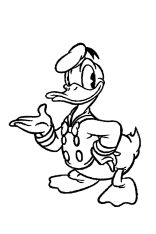
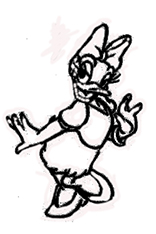
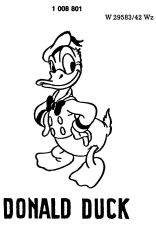
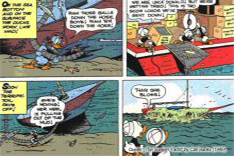
Not only protecting innovations
Social Media